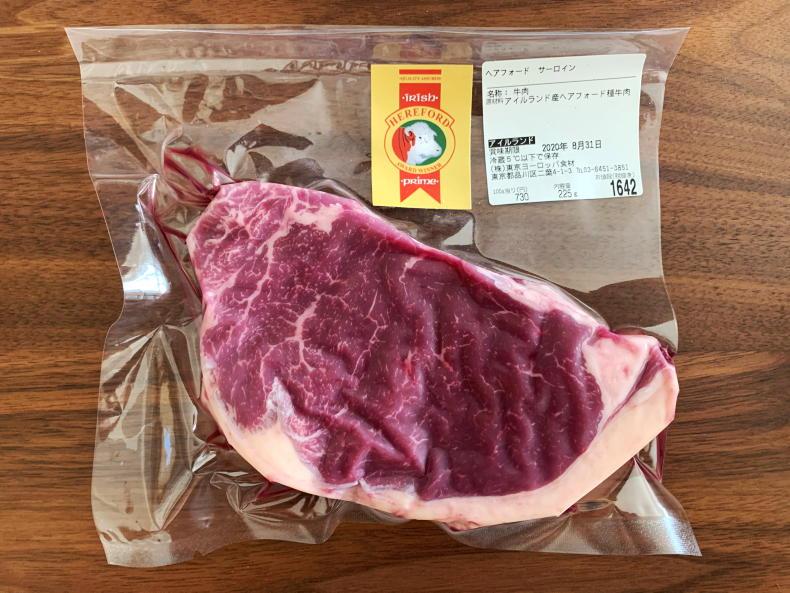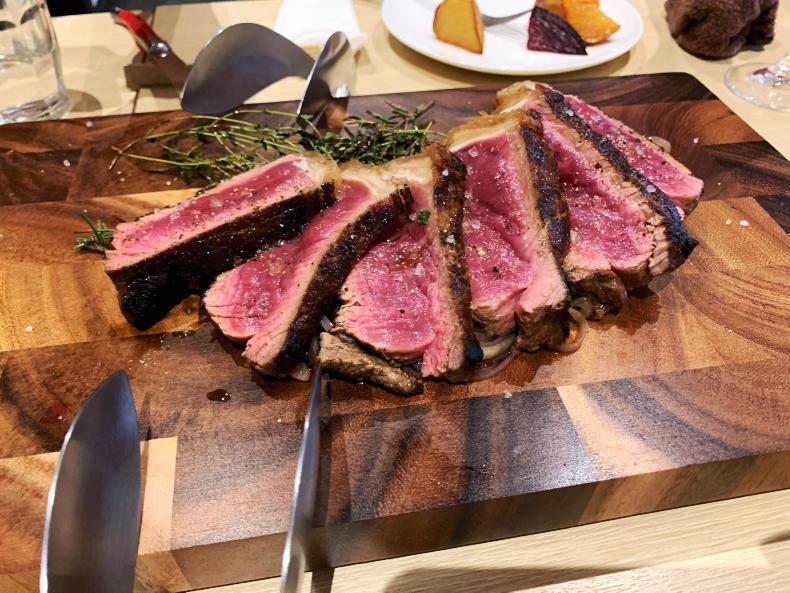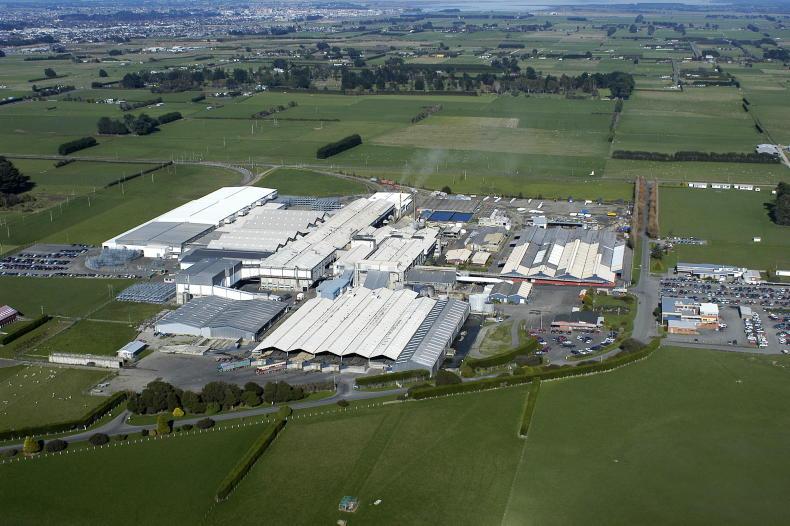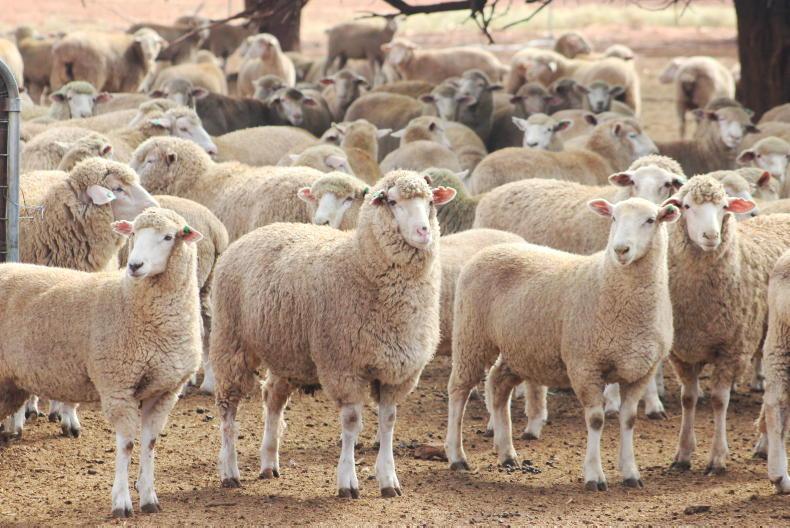Japan: a growing
market for Irish beef
Joe Moore, Bord Bia East Asia market specialist
Market access for Irish beef to Japan was realised in 2015 and further expanded in 2019 with the removal of the 30-month age restriction.
In March this year, following extensive negotiations between the Department of Agriculture and its counterpart in Japan, access for Irish beef exports was expanded to include minced meat and burger patties.
This advance will further enhance opportunities for Irish beef and its reputation in the market.
Exports of beef to Japan have grown considerably over the past 18 months. In 2019, total exports of Irish beef, including offal, were 2,477t, worth €9.5m. In 2020, this grew to 4,800t, an increase of 95%, and was valued at €15.7m, making Ireland the seventh-largest beef exporter to Japan.

Irish Hereford prime is available on Rakuten, the Amazon of Japan.
There are several key factors driving this growth. After initial success with offal, and in particular tongue, in recent years Japan has become a destination for prime cuts. The import duty on beef from Europe is gradually decreasing due to the Japan-EU Economic Partnership Agreement. From 38.5% in 2018, the duty is now 25%, levelling the playing field between Ireland and our key competitors, Australia, which commands 44% market share, and the US, with 42% market share.
Supply from Australia has decreased dramatically over the past 12 to 18 months, and this has encouraged Japanese importers to diversify their supply. With a risk-averse business culture, this diversification is likely to stick.
In addition, and perhaps most importantly, knowledge and awareness of Ireland as a stable source of quality beef is increasing. This is down to the sustained efforts of the industry to break into the Japan market. A strong piece of evidence was the increased traffic to Bord Bia’s stand at last month’s Foodex trade fair, Japan’s largest food and drink trade show which took place in a regular, live format from 9-12 March.
South Korea:
market access is key
Jack Hogan, Bord Bia market specialist – EU programmes Asia
Opening up market access for Irish beef to South Korea remains a priority for Ireland, and once access is granted we are in a position to hit the ground running and maximise the opportunity on offer. Under the EU-South Korea free-trade agreement, Irish beef will enjoy a preferential tariff rate of 15% on frozen boneless beef, a 50% discount compared to the most favoured nation tariff rate. The US, which is the largest beef exporter to South Korea, enjoys a preferential tariff rate of 13.3%, while the second-largest exporter, Australia, has an 18.6% tariff rate. Under existing bilateral trade agreements, South Korea’s import duties on US beef will be eliminated by 2026, by 2027 for Irish/EU beef and by 2028 for Australian beef.
Competitors and consumption
South Korean consumers are the highest per-capita consumers of meat across Asia, with a total of 79kg per person, with beef accounting for 17kg of this. Furthermore, meat consumption is forecast to grow over the next four years, with beef consumption predicted to grow by 1% year on year, while pork consumption will grow by 1.5% year on year (Source: Fitch Solutions, 2020).
Domestically produced hanwoo beef is the top preference for South Korean consumers. It is similar to Japanese wagyu but with a slightly lower fat content, and commands a premium price in Korea. However, South Korea is only 35% self-sufficient in beef production, meaning it relies heavily on imported beef to satisfy its sizeable demand.
Growing popularity of imported meat
The majority of imported beef is consumed via the food service channel, with Korean barbecue restaurants acting as the driving force. These restaurants are ingrained in Korean culture. The meat is cooked at the table, giving diners a unique eating experience, allowing them to check the quality of the raw meat and cook it to their preference.
Korea’s e-commerce channel is already one of the largest in the world and is also an important channel for imported beef sales, with the COVID-19 pandemic helping to further accelerate this already well-developed route to the consumer.
In 2020, South Korea imported over 481,777t of beef, of which 92% came from the US and Australia. Frozen boneless beef is the most commonly imported beef product, accounting for over 41% of total imports, followed by frozen bone-in with 30%, while chilled beef accounts for just 20% (Source: IHS Markit 2021). Brazil, traditionally a major player in Asia, does not have access to the Korean market. The Netherlands and Denmark were the first EU states to be granted beef access into Korea in 2019. However, neither has yet made any significant shipments into the market.
Given the strength of US beef in the market, awareness of grain-fed is high among Korean consumers. However, there is a trend towards more natural and healthy products, which grass-fed beef is in a position to satisfy.
Philippines:
largest Asian market
for Irish Beef
Malcolm Leoi, Bord Bia Southeast Asia market specialist
The Philippines is the largest importer of Irish beef and beef offal outside of Europe, accounting for 22,790 metric tonnes of exports in 2020. Ireland is the third-largest supplier of this important Southeast Asian market, with a share of 14%, behind only Australia (44%) and Brazil (23%). The total value of Irish beef exported to the Philippines is estimated at €44m in 2020.
The most consumed protein in the Philippines has traditionally been pork, with beef a distant competitor. However, since African Swine Fever (ASF) was first detected in the country in July 2019, the domestic hog herd, housed predominantly in backyard farms with little biosecurity, has been reduced by nearly half.
Additionally, ASF outbreaks in Germany, a major pork supplier to the Philippines, have resulted in import bans, further reducing supply and driving up prices. With rising inflation (+4.2% in January 2021, the highest in two years and driven primarily by rising food prices) threatening political stability amid pandemic-induced lockdowns, the government in February took the unusual step of instituting meat price controls in the capital Manila.
These measures seem to not have worked as intended; as of 26 March, President Rodrigo Duterte proposed allowing additional pork to be imported under the more favourable tariff regime known as the Minimum Access Volume.
Analysts expect price volatility to continue in the near-term as the Philippines battles the dual threats of ASF and COVID-19. In fact, pork has now become nearly as expensive as beef, prompting middle and upper-class consumers to consider switching, especially during festive seasons or family occasions.
In the medium term, these trends will provide tailwinds for both Irish pork and beef; and in the long term, the Philippines still retains its attractiveness as an export market due to macroeconomic factors such as a young, rapidly urbanising population, a rising middle class and an insatiable demand for protein – most of which will continue to be supplied through imports.
Raising awareness of Ireland in international markets
Declan Fennell, Bord Bia
senior manager EU promotions
Building Ireland’s identity as a food producer can be challenging outside of the EU. Many international buyers would have difficulty finding Ireland on the map, let alone understanding our sustainable food production systems.
There is, however, good recognition of the EU in Asia and therefore it makes sense to promote Ireland as one of the countries that make up the EU. It is also helpful that the EU has a promotion fund for promotion of EU food in wider global markets.
These are campaigns for which the EU provides approximately 80% of funding and which allow member states to promote EU produce to food buyers and consumers inside and outside the EU. Operating under an EU umbrella allows Ireland to leverage the reputation of the EU while simultaneously building the identity of Irish food production.
Campaign
In 2019, Bord Bia began a €3.8m campaign promoting European pork and beef in South Korea, the Philippines and Vietnam. Under the heading EU Pork & Beef: Love the Taste, Trust the Quality, the campaign is actively positioning Ireland as a key source of sustainable, high-quality meat in the Southeast Asian region.
The campaign is now in its final year and just finished a busy March targeting trade buyers and chefs through a chef masterclass tour in Vietnam, a culinary school masterclass in the Philippines, and an ‘East Meets West’ culinary competition in both Vietnam and South Korea.
Bord Bia will submit a total of five EU applications this year. These include a dairy ingredients campaign targeting Southeast Asia, a fruit and vegetable campaign in partnership with Belgium and France, and a mushroom campaign to run in the UK.
Two beef and lamb applications will be submitted – a €3.7m campaign targeting China, Japan and South Korea and a €4.1m promotion in China, Japan, South Korea and the USA.
The Commission will notify applicants of their successful applications in October 2021.
Japan: a growing
market for Irish beef
Joe Moore, Bord Bia East Asia market specialist
Market access for Irish beef to Japan was realised in 2015 and further expanded in 2019 with the removal of the 30-month age restriction.
In March this year, following extensive negotiations between the Department of Agriculture and its counterpart in Japan, access for Irish beef exports was expanded to include minced meat and burger patties.
This advance will further enhance opportunities for Irish beef and its reputation in the market.
Exports of beef to Japan have grown considerably over the past 18 months. In 2019, total exports of Irish beef, including offal, were 2,477t, worth €9.5m. In 2020, this grew to 4,800t, an increase of 95%, and was valued at €15.7m, making Ireland the seventh-largest beef exporter to Japan.

Irish Hereford prime is available on Rakuten, the Amazon of Japan.
There are several key factors driving this growth. After initial success with offal, and in particular tongue, in recent years Japan has become a destination for prime cuts. The import duty on beef from Europe is gradually decreasing due to the Japan-EU Economic Partnership Agreement. From 38.5% in 2018, the duty is now 25%, levelling the playing field between Ireland and our key competitors, Australia, which commands 44% market share, and the US, with 42% market share.
Supply from Australia has decreased dramatically over the past 12 to 18 months, and this has encouraged Japanese importers to diversify their supply. With a risk-averse business culture, this diversification is likely to stick.
In addition, and perhaps most importantly, knowledge and awareness of Ireland as a stable source of quality beef is increasing. This is down to the sustained efforts of the industry to break into the Japan market. A strong piece of evidence was the increased traffic to Bord Bia’s stand at last month’s Foodex trade fair, Japan’s largest food and drink trade show which took place in a regular, live format from 9-12 March.
South Korea:
market access is key
Jack Hogan, Bord Bia market specialist – EU programmes Asia
Opening up market access for Irish beef to South Korea remains a priority for Ireland, and once access is granted we are in a position to hit the ground running and maximise the opportunity on offer. Under the EU-South Korea free-trade agreement, Irish beef will enjoy a preferential tariff rate of 15% on frozen boneless beef, a 50% discount compared to the most favoured nation tariff rate. The US, which is the largest beef exporter to South Korea, enjoys a preferential tariff rate of 13.3%, while the second-largest exporter, Australia, has an 18.6% tariff rate. Under existing bilateral trade agreements, South Korea’s import duties on US beef will be eliminated by 2026, by 2027 for Irish/EU beef and by 2028 for Australian beef.
Competitors and consumption
South Korean consumers are the highest per-capita consumers of meat across Asia, with a total of 79kg per person, with beef accounting for 17kg of this. Furthermore, meat consumption is forecast to grow over the next four years, with beef consumption predicted to grow by 1% year on year, while pork consumption will grow by 1.5% year on year (Source: Fitch Solutions, 2020).
Domestically produced hanwoo beef is the top preference for South Korean consumers. It is similar to Japanese wagyu but with a slightly lower fat content, and commands a premium price in Korea. However, South Korea is only 35% self-sufficient in beef production, meaning it relies heavily on imported beef to satisfy its sizeable demand.
Growing popularity of imported meat
The majority of imported beef is consumed via the food service channel, with Korean barbecue restaurants acting as the driving force. These restaurants are ingrained in Korean culture. The meat is cooked at the table, giving diners a unique eating experience, allowing them to check the quality of the raw meat and cook it to their preference.
Korea’s e-commerce channel is already one of the largest in the world and is also an important channel for imported beef sales, with the COVID-19 pandemic helping to further accelerate this already well-developed route to the consumer.
In 2020, South Korea imported over 481,777t of beef, of which 92% came from the US and Australia. Frozen boneless beef is the most commonly imported beef product, accounting for over 41% of total imports, followed by frozen bone-in with 30%, while chilled beef accounts for just 20% (Source: IHS Markit 2021). Brazil, traditionally a major player in Asia, does not have access to the Korean market. The Netherlands and Denmark were the first EU states to be granted beef access into Korea in 2019. However, neither has yet made any significant shipments into the market.
Given the strength of US beef in the market, awareness of grain-fed is high among Korean consumers. However, there is a trend towards more natural and healthy products, which grass-fed beef is in a position to satisfy.
Philippines:
largest Asian market
for Irish Beef
Malcolm Leoi, Bord Bia Southeast Asia market specialist
The Philippines is the largest importer of Irish beef and beef offal outside of Europe, accounting for 22,790 metric tonnes of exports in 2020. Ireland is the third-largest supplier of this important Southeast Asian market, with a share of 14%, behind only Australia (44%) and Brazil (23%). The total value of Irish beef exported to the Philippines is estimated at €44m in 2020.
The most consumed protein in the Philippines has traditionally been pork, with beef a distant competitor. However, since African Swine Fever (ASF) was first detected in the country in July 2019, the domestic hog herd, housed predominantly in backyard farms with little biosecurity, has been reduced by nearly half.
Additionally, ASF outbreaks in Germany, a major pork supplier to the Philippines, have resulted in import bans, further reducing supply and driving up prices. With rising inflation (+4.2% in January 2021, the highest in two years and driven primarily by rising food prices) threatening political stability amid pandemic-induced lockdowns, the government in February took the unusual step of instituting meat price controls in the capital Manila.
These measures seem to not have worked as intended; as of 26 March, President Rodrigo Duterte proposed allowing additional pork to be imported under the more favourable tariff regime known as the Minimum Access Volume.
Analysts expect price volatility to continue in the near-term as the Philippines battles the dual threats of ASF and COVID-19. In fact, pork has now become nearly as expensive as beef, prompting middle and upper-class consumers to consider switching, especially during festive seasons or family occasions.
In the medium term, these trends will provide tailwinds for both Irish pork and beef; and in the long term, the Philippines still retains its attractiveness as an export market due to macroeconomic factors such as a young, rapidly urbanising population, a rising middle class and an insatiable demand for protein – most of which will continue to be supplied through imports.
Raising awareness of Ireland in international markets
Declan Fennell, Bord Bia
senior manager EU promotions
Building Ireland’s identity as a food producer can be challenging outside of the EU. Many international buyers would have difficulty finding Ireland on the map, let alone understanding our sustainable food production systems.
There is, however, good recognition of the EU in Asia and therefore it makes sense to promote Ireland as one of the countries that make up the EU. It is also helpful that the EU has a promotion fund for promotion of EU food in wider global markets.
These are campaigns for which the EU provides approximately 80% of funding and which allow member states to promote EU produce to food buyers and consumers inside and outside the EU. Operating under an EU umbrella allows Ireland to leverage the reputation of the EU while simultaneously building the identity of Irish food production.
Campaign
In 2019, Bord Bia began a €3.8m campaign promoting European pork and beef in South Korea, the Philippines and Vietnam. Under the heading EU Pork & Beef: Love the Taste, Trust the Quality, the campaign is actively positioning Ireland as a key source of sustainable, high-quality meat in the Southeast Asian region.
The campaign is now in its final year and just finished a busy March targeting trade buyers and chefs through a chef masterclass tour in Vietnam, a culinary school masterclass in the Philippines, and an ‘East Meets West’ culinary competition in both Vietnam and South Korea.
Bord Bia will submit a total of five EU applications this year. These include a dairy ingredients campaign targeting Southeast Asia, a fruit and vegetable campaign in partnership with Belgium and France, and a mushroom campaign to run in the UK.
Two beef and lamb applications will be submitted – a €3.7m campaign targeting China, Japan and South Korea and a €4.1m promotion in China, Japan, South Korea and the USA.
The Commission will notify applicants of their successful applications in October 2021.











SHARING OPTIONS